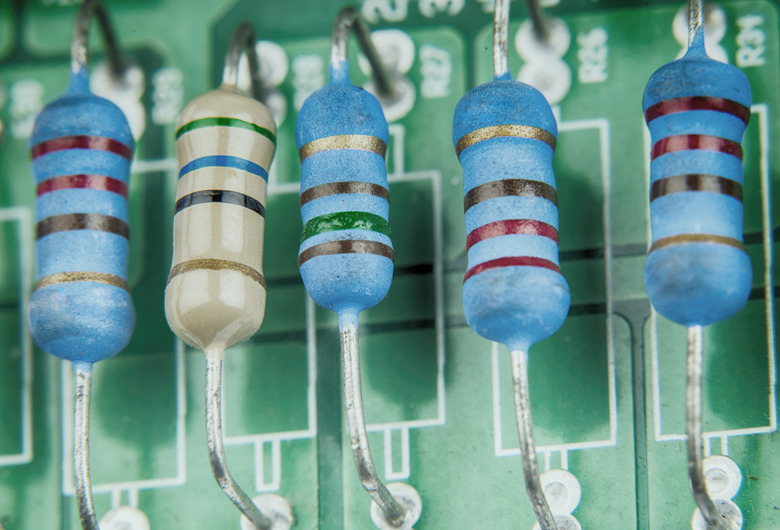Uses Of Resistors
Resistors are electrical components that help control the flow of current in a circuit. A high resistance means there is less current available for a given voltage. Inside a resistor, electrons collide with ions, slowing the flow of electricity and lowering the current while producing heat.
Transistors and LEDs
Transistors and LEDs
Transistors and LEDs are devices sensitive to electrical current; too much current will destroy them, but too little prevents them from working properly. A resistor of the correct value, placed in the circuit, allows transistors, LEDs and other semiconductor components to function in the current range that suits them best.
Timing and Frequency
Timing and Frequency
Many circuit designs use a resistor connected to a capacitor to provide a timing source; light flashers, electronic sirens and many other circuits depend on this feature. The capacitor, which holds electric charge like a cup holds water, takes a certain amount of time to fill with current, and the resistor determines how fast the capacitor fills up. If you multiply the ohm value of a resistor by the farad value of a capacitor, you get a time value measured in seconds; as resistance increases, the circuit's time period also increases.
Voltage Divider
Voltage Divider
A voltage divider is a "daisy chain" of resistors connected together, one after the other, forming a series circuit. If the resistors are all of the same value, the voltage drop across each is equal; otherwise it is a proportion determined by the resistance of each resistor and the total resistance of all the resistors in the divider. Voltage dividers are useful for components that need to operate at a lesser voltage than that supplied by the input.
Resistors for Heating
Resistors for Heating
Because resistors convert electrical energy into heat they make good heating elements for toasters, heaters, electric stoves and similar devices. Traditional light bulbs work because the very high temperature from their resistance turns a metal filament white-hot, producing light. The formula:
\(P=I^2R\)
where P is heating power in watts, I is current in amps, and R is resistance in ohms, determines the amount of heat given off by a resistor.
User Control of Circuit Functions
User Control of Circuit Functions
Some types of resistors are variable, letting you set their resistance by sliding a slider or turning a knob. Varying resistance changes the amount of current flowing in a circuit. You can, for example, use a variable resistor to control the loudness of an amplifier, the pitch of a musical tone, or the speed of a motor.
Cite This Article
MLA
Lewis, Kim. "Uses Of Resistors" sciencing.com, https://www.sciencing.com/uses-resistors-5432023/. 2 November 2020.
APA
Lewis, Kim. (2020, November 2). Uses Of Resistors. sciencing.com. Retrieved from https://www.sciencing.com/uses-resistors-5432023/
Chicago
Lewis, Kim. Uses Of Resistors last modified March 24, 2022. https://www.sciencing.com/uses-resistors-5432023/
